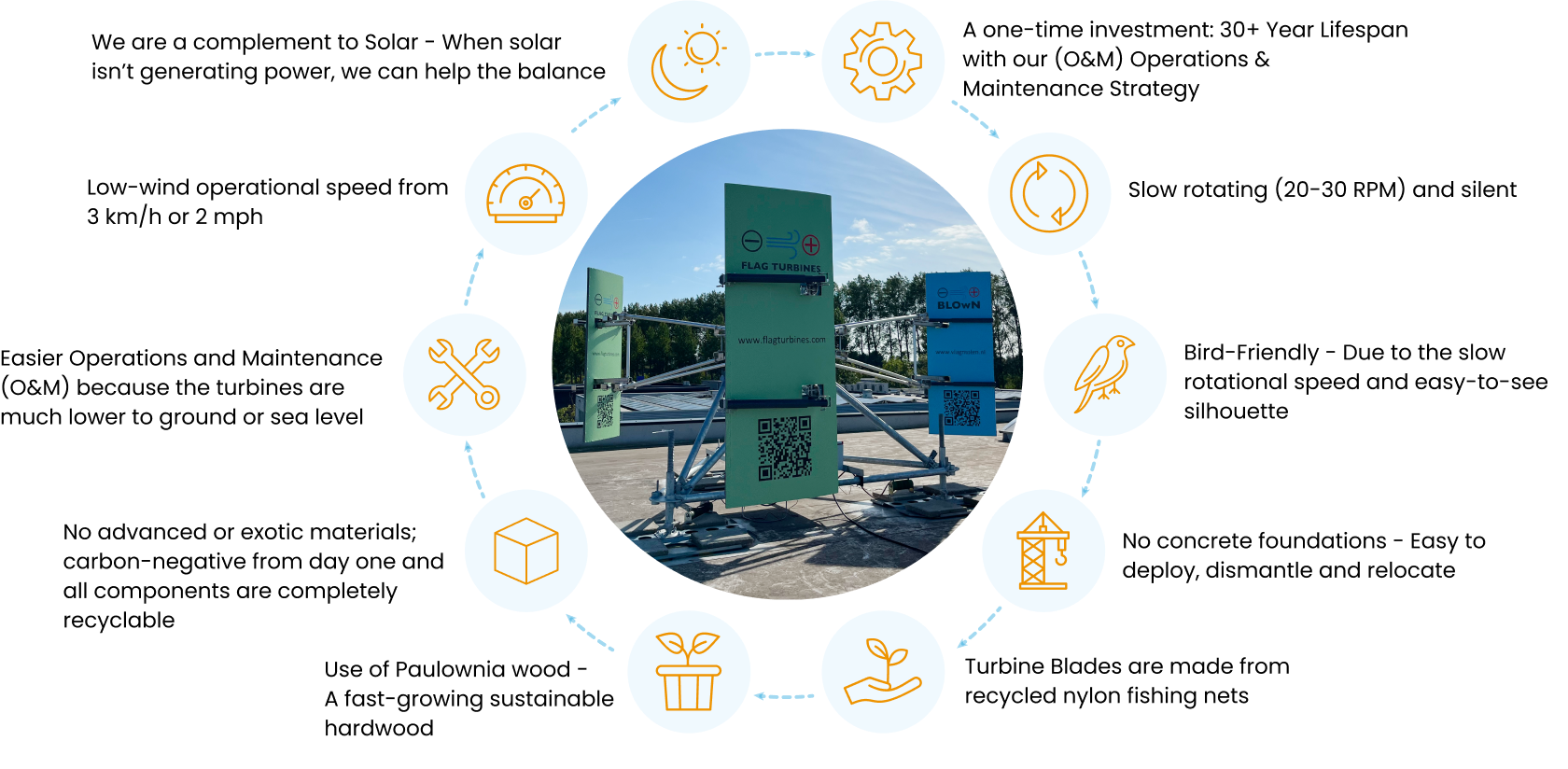Innovative approach to Wind Energy
At Flag Turbines, our mantra is: Energy Everywhere for Everyone.
We provide flexible, scalable vertical-axis wind turbines (VAWTs) that meet diverse energy needs, delivering sustainable solutions for communities and businesses. Our turbines are not only more affordable but also feature lower operations and maintenance (O&M) costs, making renewable energy both accessible and cost-effective.
MODULAR AND SCALABLE WIND ENERGY
Flag Turbines is uniquely positioned for modular wind power solutions thanks to our innovative patented design, which captures wind from any direction. Our turbines are optimized for installation in decentralized locations, including urban, rural, and floating environments. This flexibility makes them ideal for modular setups, allowing seamless scaling to meet energy demands. By integrating modular wind power, our clients can achieve scalable and efficient renewable energy generation, no matter the setting.

ENERGY EVERYWHERE, FOR EVERYONE
Flag Turbines products are more affordable than traditional ‘propeller’ style turbines due to our simpler design, which reduces manufacturing and maintenance costs. We have a unique ability to function efficiently in lower wind speeds and be installed in diverse locations, without the need for expensive site-specific concrete foundations. We are dedicated to making Energy Everywhere, for Everyone a reality through our innovative, accessible energy solutions.
We are 100% sustainable
Flag Turbines complement solar power by generating electricity not only alongside solar panels but also when solar energy is unavailable, such as at night or on overcast days. This creates a more balanced and reliable renewable energy supply, reducing dependence on solar power alone. Flag Turbines are suitable for urban and small spaces, similar to solar panels, making them ideal for combined systems. By integrating Flag Turbines with solar panels and battery storage, we can achieve a more consistent, round-the-clock renewable energy solution.

Power and Wind Speed Relationship
Our patented, slow-rotating, direct-drive, high-torque turbines are engineered to excel in turbulent, omnidirectional wind conditions. Capturing wind from 360° makes them ideal for challenging environments where traditional propeller-style turbines fall short. Our turbines have a blade surface area twice that of a conventional rotor-disc turbine of similar height and feature a patented blade pitching mechanism that continuously adjusts blade angles during every rotation. When the wind is behind the blade, the angle is optimized for maximum push by the wind, then as the blade returns to face into the wind, the blade angle adjusts to minimise the wind-facing surface. This is similar to adjusting a yacht’s sail during tacking and jibing to harness wind power efficiently.
The power output of a wind turbine is proportional to the cube of the wind speed. This means that doubling the wind speed doesn’t just double the power – for instance, increasing wind speed from 10 km/h to 20 km/h results in an 8-fold increase in energy output. Similarly, tripling the wind speed (from 10 km/h to 30 km/h) leads to a 27-fold increase, and quadrupling it (from 10 km/h to 40 km/h) produces a 64-fold increase.
In contrast, solar panels will only see a doubling in output under ideal conditions, such as transitioning from cloudy to full sunlight. Yes, of course there will be windless days when solar energy outperforms wind turbines; however, any ‘lost’ days can easily be recouped by just a few moderately windy ones. In fact, a few high-wind months during the year can often generate more energy than an entire year’s worth of solar power.